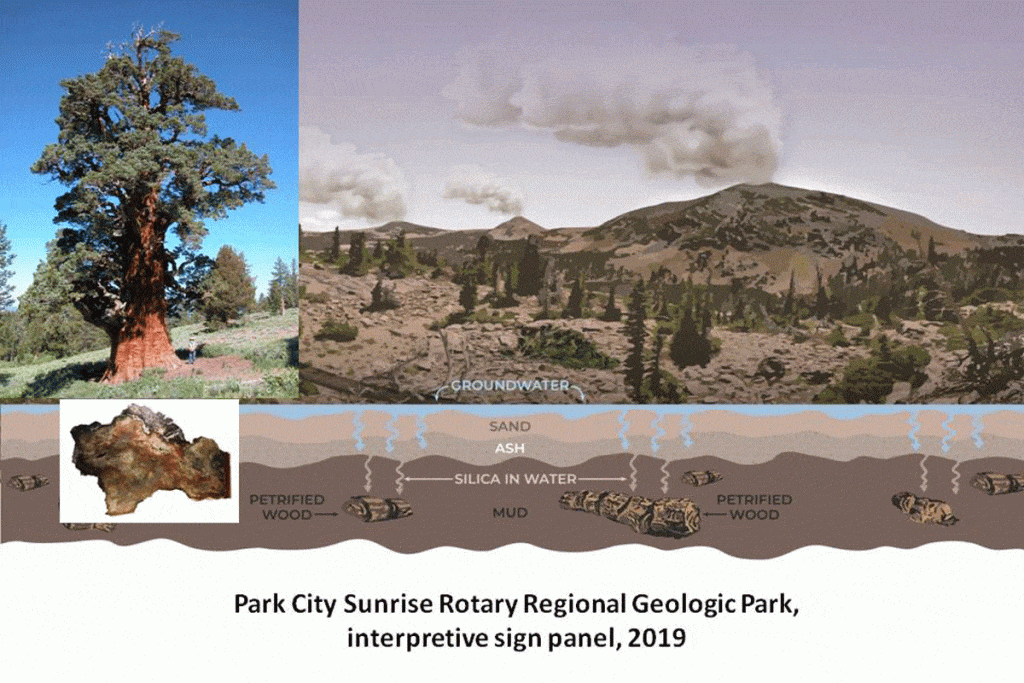Hot solutions rich in silver, lead, and zinc infiltrated the Park City underground. These minerals are the origin and evolution of our mining heritage.
We now are learning more about the associated consequences of this underlying geology. Some 30 to 40 million years ago, towering volcanoes and Mount-Saint-Helens-type of volcanic eruptions dominated this area. Evidence of our tumultuous past is especially telling in exposures of Keetley Volcanics east of U.S. Route 40.
Hike or bike the perimeter trail east of the Jordanelle Reservoir and imagine yourself on the forested slope of a steep-sided volcano. This volcano (the Park Premier) was one of several. Due to weathering, erosion, and even catastrophic collapse, the volcanic cone is long gone. What remains is the Park Premier intrusions, a source of Park City’s precious metals.
An intriguing consequence of this volcanism in Summit County, is petrified wood. Trees thrived on the flanks of the volcanoes. In the warmer and wetter climate, some became giant conifers. Volcanic eruptions, debris flows, and silica-rich ash quickly buried trees large and small. This prevented decay and began the slow process of turning wood to stone. Silica-rich groundwater seeped into the ring structures of the wood, infiltrated the cells, coated cell walls, and filled intercellular cavities. As a result, the growth rings, bark, and knots of some 35 million-year-old trees are well preserved.

Courtesy of the Bill Loughlin and Utah Geological Survey.
Pictured in the graphic is a slice of a giant petrified log, which was unearthed in 1997 in the Silver Creek area. It is on display in the Sheldon Richins Building at Kimball Junction. The newly dedicated Park City Geologic Park east of U.S. 40 marks the discovery site. The huge tree pictured here with surrounding volcanoes is analogous to the way we were some 35 million years ago.
In many ways, Park City is a great host. We were host to the World during the 2002 Winter Olympics. With perfect snow, we host hordes of skiers every winter. With cool summers and mountain trails we host ever-increasing numbers of summer recreationists. With favorable sedimentary rocks and perfect fractures, Park City attracted, and now hosts, the precious metals of our mining legacy. From Park City, the tilted and faulted layers of sedimentary rock are visible on the Wasatch Back. Their erosional remnants impact your hiking, biking, and skiing. Here is their geologic history…
The Paleozoic Era – Back in time some 300 million years: The Park City area was covered by shallow tropical seas. Layer upon layer of sediment accumulated on the sea floor. Eventually these layers were subjected to a great depth of burial, compacted, and lithified into sedimentary rock.
The Mesozoic Era – Back in time some 200 million years: The North American plate rifted from Africa and Europe and began its relentless journey from the tropics northward and westward with the opening of the Atlantic Ocean at the trailing edge. The sedimentary rock layers of this age in Park City indicate coastal environments, great rivers, and vast deserts. The great stress of moving tectonic plates and mountain building tilted, folded, and fractured the once horizontal layers. The significant structure, the Park City anticline, with its essential faults and fractures, became the host to vein, lode, and bedded replacement deposits of silver, lead, and zinc.
For more about Park City’s geologic past, keep an eye out for a Museum lecture by Sherie C. Harding, PhD, Paleontology-Ichnology on the Park City Museum website and YouTube channel for virtual viewing.